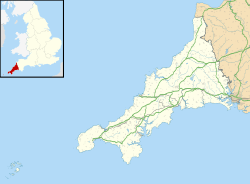Leaze stone circle facts for kids
| Location | Bodmin Moor, Cornwall |
|---|---|
| Coordinates | 50°33′56″N 4°37′57″W / 50.565529°N 4.63246°W |
| Type | Stone circle |
| History | |
| Periods | Bronze Age |
The Leaze stone circle is an ancient monument found on Bodmin Moor in Cornwall, UK. A stone circle is a special type of prehistoric monument. It is made from large standing stones arranged in a circle. People built these circles a very long time ago, often during the Bronze Age.
Contents
What is the Leaze Stone Circle?
The Leaze stone circle is located in a field near Leaze farm. It is made up of sixteen large stones. Six of these stones have fallen over time. The circle is about 24 meters (79 feet) wide. A hedge cuts through the middle of it. Experts believe the circle once had 22 stones.
There is also one stone outside the main circle. Three small dips nearby might show where other stones once stood. The stones are made of granite and are roughly square-shaped. They are about 1.2 meters (4 feet) tall and 0.5 meters (1.6 feet) wide.
What Can You See from the Circle?
From the Leaze stone circle, you can see several hills. These include Rough Tor, Tolborough Tor, and Catshole Tor. Brown Willy, which is Cornwall's highest point, is hidden behind Garrow Tor.
Other Nearby Ancient Sites
You can find the broken remains of two other stone circles about 300 meters (984 feet) northwest. These are called the Emblance Downs stone circles. Less than 1 kilometer (0.6 miles) away to the northwest is a mysterious ancient enclosure. It is known as King Arthur's Hall.
How Were the Stones Lined Up?
What is an Alignment?
An "alignment" means how ancient people might have lined up the stones with important things. This could be the rising or setting sun, the moon, or certain stars. These alignments might have helped them track the seasons or important dates.
Solar Alignment at Leaze
A scientist named Alexander Thom studied the Leaze stone circle. He suggested that some stones at the site lined up with the sun. This is called a solar alignment. It shows how clever ancient people were in understanding the sky.


